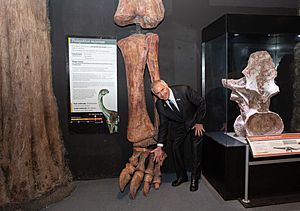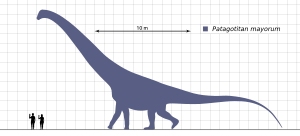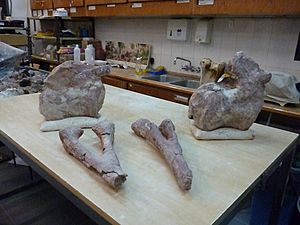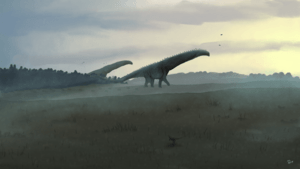Patagotitan facts for kids
Quick facts for kids Patagotitan |
|
|---|---|
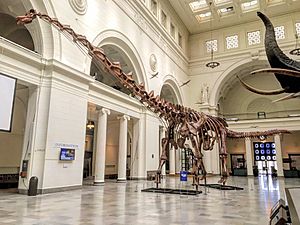 |
|
| Reconstructed skeleton on display at the Field Museum of Natural History, Chicago, Illinois, U.S. | |
| Scientific classification |
|
| Kingdom: | Animalia |
| Phylum: | Chordata |
| Clade: | Dinosauria |
| Clade: | Saurischia |
| Suborder: | †Sauropodomorpha |
| Clade: | †Sauropoda |
| Clade: | †Titanosauria |
| Clade: | †Lithostrotia |
| Clade: | †Lognkosauria |
| Genus: | †Patagotitan Carballido et al., 2017 |
| Type species | |
| †Patagotitan mayorum Carballido et al., 2017
|
|
Patagotitan (say: Pat-uh-go-TY-tan) is a type of giant dinosaur called a titanosaur. Titanosaurs were a group of very large, long-necked, plant-eating dinosaurs known as sauropods. This amazing dinosaur lived in what is now Patagonia, Argentina, during the Cretaceous Period.
Scientists have found bones from at least six young adult Patagotitan dinosaurs. The only known species is Patagotitan mayorum. It was first announced in 2014 and officially named in 2017 by a team of scientists led by José Carballido. When it was first discovered, some thought Patagotitan might be the largest land animal ever! Early estimates suggested it was about 37 meters (121 feet) long and weighed around 69 tonnes (76 short tons).
Later studies suggested it was a bit smaller, perhaps around 31 meters (102 feet) long and weighing between 50 to 57 tonnes (55-63 short tons). This means it was similar in size to other huge dinosaurs like Argentinosaurus and Puertasaurus. Even so, Patagotitan is one of the best-known titanosaurs, and its fossils have helped scientists learn a lot about this group of giant dinosaurs.
Like its relatives, Patagotitan was a very large and strong titanosaur. It had special features in its back and tail bones, as well as its arm and leg bones, that make it unique. For example, it had a special way its backbones connected, which likely helped it carry its massive weight. Patagotitan lived in a forested area with many conifer trees, like modern-day cypress trees.
Contents
Discovery of Patagotitan
The first bone of Patagotitan was found in 2010 by a farm worker named Aurelio Hernández. He discovered a part of a huge leg bone in the desert near La Flecha, Argentina. This was about 250 kilometers (155 miles) west of Trelew.
Aurelio reported his amazing find to the Museum of Paleontology Egidio Feruglio (MPEF) in Trelew. Scientists from the MPEF began exploring the site in late 2012. They then carried out seven more expeditions between January 2013 and February 2015. The main scientists leading this work were Jose Luis Carballido and Diego Pol.
During these digs, they uncovered more than 200 fossils! This included 130 bones from sauropods and 57 teeth from meat-eating dinosaurs. The rocks where the fossils were found are about 101.62 million years old. This means Patagotitan lived during the late Albian age of the Cretaceous Period.
The sauropod fossils belonged to at least six different dinosaurs. Scientists believe they were all the same species because their bones looked very similar and were about the same size. Even though all the bones came from the same quarry, the dinosaurs probably didn't all die at the same time. The fossils were found in three different layers of sediment, suggesting three separate burial events.
One skeleton was chosen as the main specimen, called the holotype. It was the best-preserved and showed the most unique features of the new species. This skeleton included parts of the neck, back, and tail, as well as ribs, shoulder bones, hip bones, and both thigh bones. Other skeletons found were called paratypes. These included bones from other individuals, like neck and back bones, tail bones, arm bones, and leg bones.
In 2017, the scientists officially named these remains Patagotitan mayorum. The name Patagotitan combines "Patagonia" (where it was found) with "Titan" (from Greek mythology, meaning giant). This refers to the dinosaur's huge size and strength. The second part of the name, mayorum, honors the Mayo family, who owned the ranch where the bones were found. Because so many bones were found, Patagotitan is one of the most complete titanosaur skeletons ever discovered.
Exhibits

You can see huge skeletons of Patagotitan in several museums around the world. Scientists used digital scans of the real bones to create foam molds, fiberglass casts, and 3D-printed parts for these displays.
One skeleton is on display at the Museum of Paleontology Egidio Feruglio in Argentina, where the fossils were first studied. Another impressive display is at the American Museum of Natural History in New York. There, it replaced a smaller Barosaurus skeleton. Some of the original Patagotitan fossils, like a thigh bone, were also shown for a short time.
The Field Museum of Natural History in Chicago also has a Patagotitan skeleton. It took the place of "Sue," the famous Tyrannosaurus skeleton, which was moved to another exhibit. From March 2023 to January 2024, a Patagotitan display was also planned for the Natural History Museum, London.
Patagotitan Size
Like other sauropods, Patagotitan walked on four legs and ate plants. It had a very long neck and tail. Its most famous feature is its enormous size.
In 2014, when news of the discovery first came out, reports said Patagotitan was about 40 meters (131 feet) long and weighed 77 tonnes (85 short tons). The scientists who named it, Carballido and his team, published their own estimates in 2017. They said it was about 37 meters (121 feet) long. For weight, they estimated around 69 tonnes (76 short tons) using one method, and between 44.2 to 77.6 tonnes (48.7-85.5 short tons) using 3D models. These numbers suggested Patagotitan was about 10% larger than Argentinosaurus.
However, other scientists later gave different estimates. In 2019, Gregory S. Paul estimated Patagotitan at 31 meters (102 feet) long and 50 to 55 tonnes (55-61 short tons) in weight. This would make it smaller than Argentinosaurus, which he estimated to be over 35 meters (115 feet) long and 65 to 75 tonnes (72-83 short tons). In 2020, another study estimated its weight at about 55.7 tonnes (61.4 short tons).
Scientists also studied the bones themselves. They looked at slices of five thigh bones and one arm bone. This showed that the dinosaurs died when they were young adults. They were still growing, but their growth had slowed down.
Some scientists, like Matt Wedel, have pointed out that Patagotitan was similar in size to other giant titanosaurs. However, many of the bones of Argentinosaurus that could be compared were actually larger. The debate about which dinosaur was truly the "biggest" is still ongoing among paleontologists.
Patagotitan Body Features
Vertebrae
The bones in the neck of Patagotitan were very long, especially in the front and middle parts. They were at least five times longer than they were wide. The top parts of these bones, called neural spines, were flat. The backbones of Patagotitan had some unique features that helped scientists tell it apart from other titanosaurs. For example, the ridges of bone on its back vertebrae were thin and strong.
All the neural spines in its back were tall and stood straight up. The first few had expanded, arrow-shaped ends. This was different from many other titanosaurs, which had backward-sloping neural spines in their rear backs. Patagotitan also had a special way its third and fourth backbones connected, which was likely an adaptation to help support its huge weight.
The front tail bones of Patagotitan were also unique. Their front surfaces were flat, unlike most titanosaurs where they were curved. The neural spines on the front tail bones were very wide from side to side and also tall. Their tops were curved inwards, making them look a bit like they had two points.
The sides of the front tail bones had high, thin projections. These projections would have provided large areas for strong muscles to attach. This means Patagotitan likely had a very muscular tail.
Limbs and Girdles
Patagotitan had strong, wide shoulder blades. The shoulder blade was only about four times as long as it was wide at its narrowest point. This made it very robust. It also had two bumps near the shoulder joint, which is unusual and only seen in a few other giant dinosaurs. A unique ridge ran diagonally up the shoulder blade.
The upper arm bone (humerus) of Patagotitan was also very strong. It was about 28% as wide as it was long. It also had several unique bumps and scars where powerful muscles would have attached. These muscles helped move its massive limbs. The lower arm bones (ulna and radius) were also robust and strong.
In the hip area, the contact between the pubis (forward-pointing hip bone) and the ischium (backward-pointing hip bone) was quite long. The thigh bone (femur) of Patagotitan was also very robust, about 23% as wide as it was long. Like other titanosaurs, the top of the thigh bone was angled upwards. Uniquely, the outer edge of the bottom of the thigh bone had a series of rough ridges. This was where a muscle that helped move the toes would have attached. All these strong limb and girdle features helped Patagotitan support its immense body weight.
Classification of Patagotitan
In 2017, scientists studied how Patagotitan was related to other dinosaurs. They found that Patagotitan was most closely related to Argentinosaurus. These two dinosaurs were grouped together because they both had long neural spines in their front backbones. They were placed within a larger group called Lognkosauria. This group includes some of the largest titanosaurs ever found.
The following family tree shows how Patagotitan is related to other titanosaurs:
| Titanosauria |
|
|||||||||||||||||||||||||||||||||||||||||||||||||||||||||||||||||||||||||||||||||||||||||||||||||||||||||||||||||||||||||||||||||||||||||||||||||||||||||
Even though how titanosaurs are related can sometimes change with new discoveries, Patagotitan has almost always been found to be closely related to Argentinosaurus and Puertasaurus. This strong relationship helps scientists understand the larger group of titanosaurs.
In 2019, scientists named a new group called Colossosauria. This group includes the Lognkosauria (which has Patagotitan) and another group called Rinconsauria. Because Patagotitan is so well-preserved, it helps scientists define these groups more clearly.
Here is another family tree showing how Patagotitan fits into these groups, focusing on the most stable relationships:
| Titanosauria |
|
||||||||||||||||||||||||||||||||||||||||||||||||||||||||||||||||||||||||
Patagotitan's Ancient Home
Patagotitan lived in a place that was once a lush forest. Scientists found many plant fossils near the Patagotitan bones. These included ferns, leaves, cones, and fossilized wood from conifer trees. There were also some early flowering plants (angiosperms), but conifers were the most common trees.
One new type of ancient cypress tree, similar to modern Fitzroya and Pilgerodendron, was identified from the fossilized wood. These trees were estimated to be about 15.3 meters (50 feet) tall.
The rocks where the Patagotitan fossils were found are made of fine sand and silt. This suggests that the area was a floodplain with slow-moving water. The flooding was probably not strong enough to move the huge dinosaur bones far. This means the Patagotitan individuals likely died and were buried right where their fossils were found.
Other animals lived in this ancient environment too. These included the meat-eating dinosaurs Tyrannotitan and Genyodectes. There were also crocodile-like reptiles called Barcinosuchus and a type of turtle called Chubutemys.
See also
 In Spanish: Patagotitan mayorum para niños
In Spanish: Patagotitan mayorum para niños


